
Ilocos Sur, officially the Province of Ilocos Sur, is a province in the Philippines located in the Ilocos Region in Luzon. Located on the mouth of the Mestizo River is the capital of Vigan while Candon is the most-populous city. Ilocos Sur is bordered by Ilocos Norte and Abra to the north, Mountain Province to the east, La Union and Benguet to the south and the South China Sea to the west.
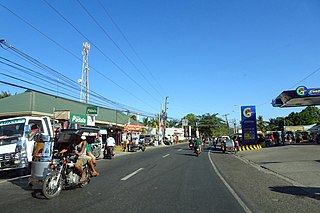
Narvacan, officially the Municipality of Narvacan, is a 2nd class municipality in the province of Ilocos Sur, Philippines. According to the 2020 census, it has a population of 46,234 people.

Cervantes, officially the Municipality of Cervantes, is a 4th class municipality in the province of Ilocos Sur, Philippines. According to the 2020 census, it has a population of 19,449 people.

Tagudin, officially the Municipality of Tagudin, is a 2nd class municipality in the province of Ilocos Sur, Philippines. According to the 2020 census, it has a population of 41,538 people.
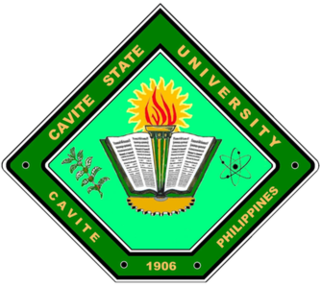
Cavite State University, also more known locally as Kabsu, is a public university in the province of Cavite in the Philippines. Its 70-hectare (170-acre) main campus, known as the Don Severino delas Alas Campus, is located in the Municipality of Indang, Cavite about 60 km (37 mi) southwest of Manila. The educational institution has twelve other campuses spread all over the province.

Philippine Rice Research Institute (PhilRice) is a government corporate entity attached to the Department of Agriculture created through Executive Order 1061 on November 5, 1985 to help develop high-yielding and cost-reducing technologies for farmers.

The legislative districts of Ilocos Sur are the representations of the province of Ilocos Sur in the various national legislatures of the Philippines. The province is currently represented in the lower house of the Congress of the Philippines through its first and second congressional districts.

Mariano Marcos State University is a higher education institution with campuses and facilities throughout Ilocos Norte province in the Philippines. Its main campus is in Batac.
Sorsogon State University (SorSU) is one of the oldest trade schools in the Philippines. It was established as Sorsogon Trade School in 1907, was renamed Sorsogon School of Arts and Trades by virtue of Republic Act 704 in June 1953 and again renamed Sorsogon College of Arts and Trades in 1976. In December 1993, after 86 years of existence, it was converted into a state college with three national vocational high schools in the province integrated to it. This was thru R.A. 7666 authored by then Cong. Salvador H. Escudero III and Sen. Leticia Ramos Shahani, approved on December 31, 1993, by President Fidel V. Ramos.
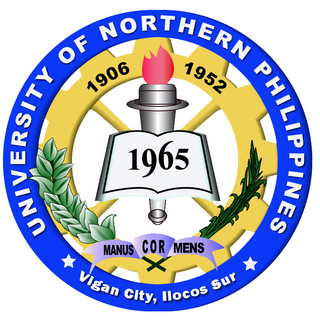
The University of Northern Philippines is a university in Barangay Tamag, in the City of Vigan in the province of Ilocos Sur, Philippines. It is the first and oldest state university in Northern Luzon which offers low tuition fee, tracing its roots to 1906, which is older than the University of the Philippines by two years. It is the only state university in the province aimed for less-fortunate people and one of three state-owned educational institutions of higher learning operating in Ilocos Sur.
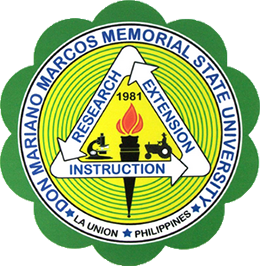
Don Mariano Marcos Memorial State University is the state university system serving the province of La Union in the Philippines. Its main autonomous unit is in Bacnotan. It was created by 10th president Ferdinand Marcos by using Presidential Decree 1778 to combine a number of state-run schools in La Union into a single state college in 1981. Like Mariano Marcos State University in Ilocos Norte, it is named for the former president's father, Mariano Marcos.

Western Philippines University is a state higher education institution located in Palawan. The university began as the Aborlan Farm Settlement School for the Tagbanuas in 1910. It became the Aborlan Agricultural High School in 1928 and then Palawan Regional Agricultural School in 1960. It was renamed Palawan National School in 1962 and became the Palawan National Agricultural College in 1963. Its name was again changed to State Polytechnic College of Palawan in 1995 by virtue of RA 8012, and in 2004, President Gloria Macapagal Arroyo signed RA 9260 converting it to Western Philippines University.

Southern Luzon State University, formerly known as Southern Luzon Polytechnic College (SLPC), is the premier, state-funded higher education institution in Quezon Province in the Philippines operating by virtue of Republic Act 9395. It is composed of 11 campuses in the province of Quezon, with the main campus situated in the Municipality of Lucban.
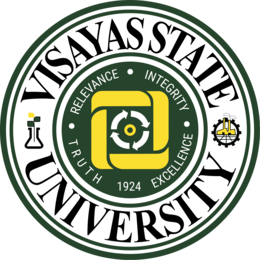
Visayas State University is a university located in the city of Baybay, Leyte, Philippines. The five-campus VSU has eight colleges, three institutes and one school. Located on the main campus are the College of Veterinary Medicine, College of Engineering and Technology, College of Education, College of Forestry and Environmental Science, College of Arts and Science, College of Nursing, College of Management and Economics, College of Agriculture and Food Sciences, Institute of Strategic Research and Development Studies, Institute of Tropical Ecology and Environmental Management, Institute of Human Kinetics, and the Graduate School and Special Programs.
Laguna State Polytechnic University is a state university in the province of Laguna, Philippines, with four regular campuses and several auxiliary sites. It is currently classified as SUC Level III.

Candon, officially the City of Candon, is a 4th class component city in the province of Ilocos Sur, Philippines. According to the 2020 census, it has a population of 61,432 people.
Mindoro State University, formerly known as the Mindoro State College of Agriculture and Technology, is a public state higher education institution in Oriental Mindoro, Philippines. It is mandated to provide higher vocational, professional and technical instruction and training in agricultural, fisheries and industrial fields. It is also mandated to promote research, advanced studies and progressive leadership in the fields of agriculture including agricultural education and home technology, with special emphasis given to agricultural industry, fishery, forestry, and industrial education. Its main campus is located in the municipality of Victoria.

Northern Iloilo State University (NISU) is a state university in the Philippines located in Western Visayas at the province of Iloilo. It is mandated to provide higher and advanced education and training in the fields of education, industrial technology, criminology, agriculture, fishery, hospitality management, engineering, sciences and information technology. It is also mandated to promote research, advanced studies, and progressive leadership in various fields. Its main campus is located in Estancia, Iloilo, Philippines. Prior to its present conversion as a university, it was called Northern Iloilo Polytechnic State College. It was elevated to a university in 2022, through Republic Act No. 10597 as amended by Republic Act 11005, and upon confirmation by the Commission on Higher Education En Banc Resolution no. 222-2022 dated April 26, 2022.

The Central Bicol State University of Agriculture, or simply referred to by its acronym CBSUA, is a state university in the province of Camarines Sur, Philippines, and is the regional center for higher learning in agriculture in the Bicol Region.

Ilocos Sur's 2nd congressional district is one of the two congressional districts of the Philippines in the province of Ilocos Sur. It has been represented in the House of Representatives of the Philippines since 1916 and earlier in the Philippine Assembly from 1907 to 1916. The district consists of the city of Candon and adjacent municipalities of Alilem, Banayoyo, Burgos, Cervantes, Galimuyod, Gregorio del Pilar, Lidlidda, Nagbukel, Narvacan, Quirino, Salcedo, San Emilio, San Esteban, Santa, Santa Cruz, Santa Lucia, Santa Maria, Santiago, Sigay, Sugpon, Suyo and Tagudin. It is currently represented in the 19th Congress by Kristine Singson-Meehan.



















